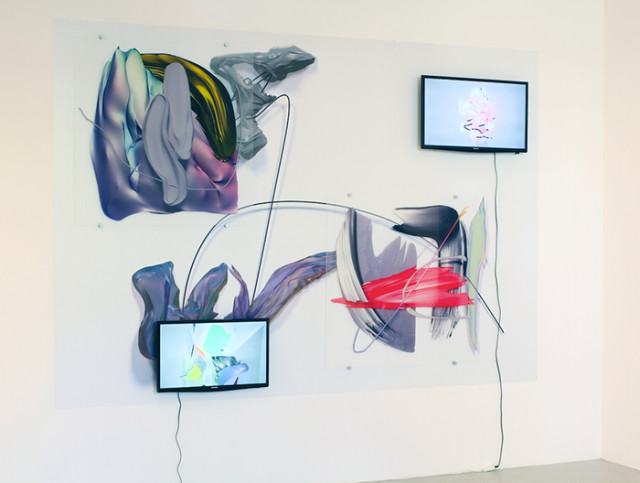
Exhibition view WHEN THE CAT’S AWAY, ABSTRACTION at Anna Jill Lüpertz Gallery, Berlin, Germany, 2016. All images courtesy of Anna Jill Lüpertz Gallery.
When The Cat’s Away, Abstraction
Anna Jill Lupertz Gallery
Berlin
Through June 4, 2016
Participating artists: Juliette Bonneviot, Manuel Fernández, Philip Hausmeier, Vince Mckelvie, and Cecilia Salama
Sometimes you happen upon an exhibition that is so bang-on in its intent and presentation that all you can do is stand back and admire its charms. Such is the lucky fate of anyone who wanders into “When The Cat’s Away, Abstraction”, a new group show highlighting works that begin from digital sources and end in traditional commodities.
“When the Cat’s Away” sticks its head into a bottomless pit of fascinating—the pit that awaits anyone who attempts to distinguish between the “real” and the “virtual” in contemporary art production—and comes out still breathing. And that alone is an accomplishment. We’re talking about a pond so mucky I need quotation marks to even begin to tackle it, as one would chopsticks to dive into a mound of slithering noodles.
Curated by Tina Sauerlander, the show starts with two very smart curatorial choices: keep the show spare and give the viewer pretty things to look at. All the theoretical bumph in the world, as many musings on “the transient zone between the physical and virtual”, to quote the didactics, as one could swallow, would be all for naught if the actual stuff on view were less than engaging or were too many to appreciate. But this exhibition is hardly a dry, windy treatise. Most of the time, it looks like a cute corner candy shop gleefully blown to bits.

Exhibition view WHEN THE CAT’S AWAY, ABSTRACTION at Anna Jill Lüpertz Gallery, Berlin, Germany, 2016, installation by Vince Mckelvie.
To wit, on the first floor, Vince McKelvie’s swipes of lurid colour applied to massive walls of Plexiglass and long, loosely hung sheaths of paper dominate the gallery space with a Pop panache. These are big, bold works full of color and life. They are likeable and clever. And they are also indicative of the key question the entire exhibition is attempting to work out, or at least present as an opening to the dialogue. And that question is a simple one about process.
Do we need to know that the amorphous images McKelvie creates are sourced from common, domestic imagery and then manipulated into dreamy proto-forms? I’m not certain. Part of me finds the process angle of this exhibition tantalizing, and part of me finds it utterly without consequence. An abstract painting by definition is supposed to exist outside the question of origin or source. Unpacking McKelvie’s works by retracing his studio steps feels a bit like staring at a 1950s abstract painting and trying to find the tree or the boat in the picture. And yet, that is why we are asked to look at them, to admire their undercarriages.
Is the fact that a final work is created via multiple applications/manipulations of digitally derived building blocks crucial to knowing the works, or is it merely one of many selling points?
I rarely argue for what I am about to suggest, but here is where I feel that the exhibition needs a clearer didactic scheme, or none at all. If the works cobbled together share a methodology that informs the appearance and power of each finished work, why not create a kind of learning moment within the exhibition wherein these processes are more thoroughly explained? Without such tools, most viewers will simply see a lot of new abstract paintings and sculptures and assume they are no more than they appear.
Which, again, might be the point of the show; to “naturalize”, so to speak, digitally-driven processes? These lingering questions make “When the Cat’s Away” feel like the beginning of an exploratory curatorial exercise and not a stand-alone exhibition. And perhaps that is why I liked it so much, because of the situational open-endedness.

Exhibition view WHEN THE CAT’S AWAY, ABSTRACTION at Anna Jill Lüpertz Gallery, Berlin, Germany, 2016, with works by (left to right): Juliette Bonneviot, Cecilia Salama, Manuel Fernández
Certainly, it defined the work I gravitated towards— Manuel Fernandez’s glowing, transparent paintings, which look like guppy-filled aquariums viewed through thick prisms, and Cecilia Salama’s gummy, pimpled sculptures; big wads of rubber that resemble melted ice lollies that have been abruptly refrozen. Both sets of works are rendered in sugary palettes and both appear themselves to be in the process of changing from liquid to solid, or the other way around, or both forms at once. The collision of digitally derived imagery and non-classical source materials with traditional, high craft object making makes for an inherently fluid practice.
It struck me after I left “When the Cat’s Away”, that all of the show’s digital and pre-digital/Pop and High Art hybridity makes for one very queer exhibition: queer in the sense of cross-pollinated, resistant to singular methodologies and/or presentations, and also, simply, playful. Queer as in limitless.


Comments on this entry are closed.